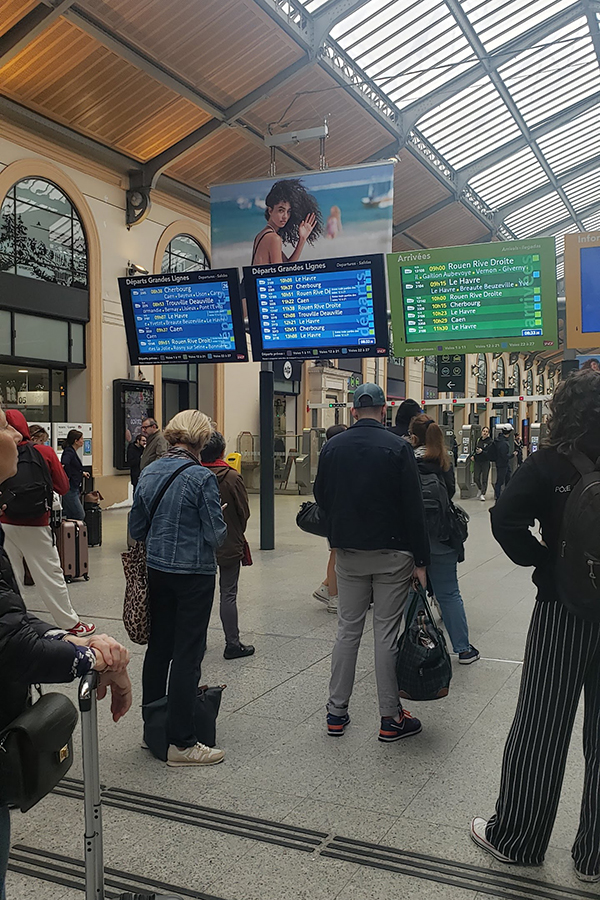Traveling by train in and around France

Train Travel in France Explained
I’m sure you’ve heard that travel by train in France (and Europe) is easily accessible and affordable, well you can believe it. Train travel throughout France and Europe is quite connected, affordable, and easy to use. Living in Paris, I use a train every day to get into the city and from there, I take 2 different types of trains throughout the city.
If you follow me on Instagram, you know that Thomas and I decided (last minute), we’d get out of dodge for a night and head up to Trouville. On my Insta page, I briefly described in a post why I love train travel. I got some good messages about train travel from Paris and decided to write this post!
This is all information from my own personal experience as well as research on this subject. As always, I am not an expert, nor am I employed by the RATP or SNCF. If you have any specific questions about details or services, please contact the appropriate authorities.
Train, Tram, RER, Metro: what's the difference?
Just so we are clear, there are 2 different companies that deal with public transportation here in Paris. RATP and SNCF. The best way to think about it is RATP, Régie Autonome des Transports Parisiens, that deals with all public transportation within the city of Paris (ie inside the péripherique). SNCF, Société Nationale des Chemins de fer Français, deals with everything else, but also runs within Paris too. Now that we’ve got that settled, we can get into the nitty-gritty.
Your main mode of transportation when in Paris will most likely be the metro and RER. I’ve met some people who prefer only the metro because they are unsure of the RER, I used to be one of those people in the beginning. But let me tell you, sometimes the RER is a quicker way to get to your destination. It will be filled with tourists, but not as many as the metro. If you’re traveling during peak rush hour, then you’ll be stuck along with the other commuters.
Types of Trains
There are several different train services under the SNCF umbrella (depending on where you are going depends on what type of train you travel on):
- TGV: Train à Grande Vitesse – France’s high-speed train.
- IC: Intercité – a step down from the TGV. Longer routes than the TER, but slower than the TGV.
- TER: Trains Exprès Regionaux – more commonly known as the suburban train. Usually connects larger cities with smaller surrounding towns.
When traveling by train, there are also certain types of trains that serve specific regions in Europe. The following types of train are all specific types of high-speed trains:
- TGV Lyria runs through France and into Switzerland.
- Eurostar services regions such as the UK, Lille, Paris, and Brussels.
- Thalys services regions such as Belgium, the Netherlands, and Germany.
Train Stations in Paris
Within Paris, there are several train stations that act as central hubs for trains as well as the RER and the métro. Each train services different regions of France and Europe. You can’t just go to any train station to get to your destination. Each of the 6 major train stations in Paris each serve a different part of France and Europe.
- Gare du Nord: serves the northern France region as well as the following European cities: London (via the Eurostar), Brussels, and Amsterdam (via Thalys).
- Gare de l’Est: serves French cities & regions such as Épernay, Metz, and Reims as well as the following European cities & regions: Munich, Frankfurt, and Zurich.
- Gare de Lyon: serves Lyon, Dijon, Besançon, Geneva, Mulhouse, Zurich, Clermont-Ferrand, Marseille, Nice, Nîmes, Montpellier, Perpignan; Italy and the east of Spain
- Gare d’Austerlitz: serves Tours, Poitiers, Limoges, Bordeaux, Toulouse, Biarritz; the western part of Spain.
- Gare Montparnasse: serves Brittany, Brest, Rennes, Nantes and all western TGVs.
- Gare St. Lazare: serves Caen, Cherbourg, Rouen, Le Havre.
Tips for traveling by train in France
Buy tickets early, especially if traveling during peak times (i.e. school holidays). Tickets are usually released for sale 90 days in advance and they go pretty fast around the holiday time.
Pack accordingly. Depending on the train type depends on the bag restrictions. Good rule of thumb: if you can carry it, you can pack it. You may also want to pack a sweater or something to over up, sometimes the AC on the trains can be a little chilly.
You’ll be able to store your big bags near the doors to the train. There are spaces before you head to your seat where you can stow your big(ger) suitcase. There’s also space above your seat for smaller bags if needed as well as below the seat in front of you.
You can pack snacks and drinks. Most trains have tray tables and you are allowed to carry on snacks, sandwiches, bottled beverages. Some trains may have a bar car with food and drink for purchase. Just be sure to throw your trash out in the proper bin afterwards.
Show up to the train station early, a minimum of 30 minutes before the train is scheduled to leave. You are guaranteed access up to 2 minutes before departure.
There are screens through out the train station that update you with departing/arriving times, and platform number. The blue screens are the departing trains and the green screens are the arriving trains. Depending on the type of train, depends on how soon the platform number shows up.
You’ll always want to check what car your seat is located on. The Nomad trains have digital screens located on the outside to tell you what car number it is. There are also screens on the inside of the cars that indicate the car number. Always verify the screens to make sure you’re in the right car.
Always check your ticket to see what seat you’re in. It will usually indicated what type of seat you have (aisle, window, folding). Then you’ll just follow the signs (see photo 7 for the indication of where seat numbers are) for your seat.
If you’re ever on a train and you want to know if a seat is taken or not (i had a traumatizing experience once and never again), check to see if there is a light indicator. If it’s red, that means the seat has been reserved. If it’s not, then it’s fair game.
Most trains have these jump seats (strapontins). You can be assigned one of these seats, like we were on our trip home. You’ll be assigned a car, but it’s like first come first serve. And honestly, they’re not that comfortable.
One downfall to train travel is strikes and/or delays. Delays/cancellations are becoming more frequent throughout France due to the pandemic and a lack of workers. I’d highly recommend downloading the SNCF Connect and SNCF Assistant apps; You’ll be able to stay up to date on any issues or cancellations. Your tickets will also appear here and you can use the QR code to scan and validate your ticket.


You May Also Like

A Christmas playlist to deck the halls during the holidays
11 December 2021
Celebrating Easter in France: From Pagan celebrations to Catholic traditions.
17 April 2022